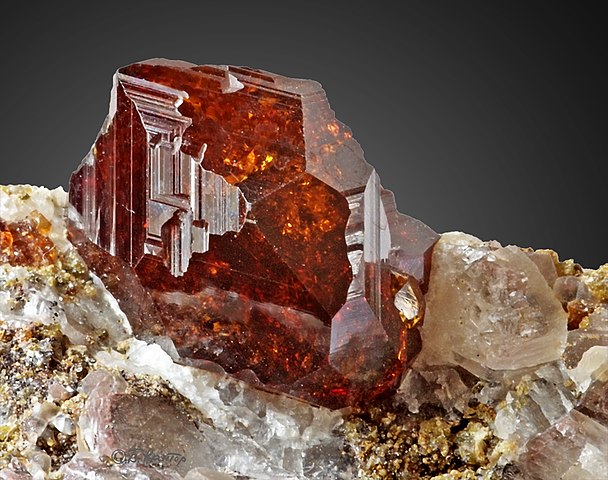Garnet
Garnet is a group of silicate minerals that have been used since the Bronze Age as gemstones and abrasives.
Etymology
The word garnet comes from the 14th-century Middle English word gernet, meaning "dark red." It is borrowed from Old French grenate from Latin granatus', from granum ("grain or seed"). This is possibly a reference to mela granatum or even pomum granatum ("pomegranate"), a plant whose fruits contain abundant and vivid red seed covers, which are similar in shape, size, and color to some garnet crystals.
Properties
Garnet species are found in every colour, with reddish shades most common. Blue garnets are the rarest and were first reported in the 1990s. Garnet species' light transmission properties can range from the gemstone-quality transparent specimens to the opaque varieties used for industrial purposes as abrasives. The mineral's luster is categorized as vitreous (glass-like) or resinous (amber-like).
The mineral garnet is commonly found in metamorphic and to a lesser extent, igneous rocks. Most natural garnets are compositionally zoned and contain inclusions.
Gemstone
Red garnets were the most commonly used gemstones in the Late Antique Roman world, and the Migration Period art of the "barbarian" peoples who took over the territory of the Western Roman Empire. They were especially used inlaid in gold cells in the cloisonné technique, a style often just called garnet cloisonné, found from Anglo-Saxon England, as at Sutton Hoo, to the Black Sea. Thousands of Tamraparniyan gold, silver and red garnet shipments were made in the old world, including to Rome, Greece, the Middle East, Serica and Anglo Saxons; recent findings such as the Staffordshire Hoard and the pendant of the Winfarthing Woman skeleton of Norfolk confirm an established gem trade route with South India and Tamraparni (ancient Sri Lanka), known from antiquity for its production of gemstones.
Pure crystals of garnet are still used as gemstones. The gemstone varieties occur in shades of green, red, yellow, and orange. The garnet family is one of the most complex in the gem world. It is not a single species, but is composed of multiple species and varieties. It is the state mineral of Connecticut, New York's gemstone, and star garnet (garnet with rutile asterisms) is the state gemstone of Idaho.
Spiritual uses
The ancient Egyptians called garnet hemaget and heavily imported the stone from India. It was used in jewelry and grave goods dating to at least the Middle Kingdom Period. Two Egyptian decans have garnet as their stone: Tepy-a Akhuy and Kenmet.
In ancient Roman mythology all red stones such as garnet, carnelian, and rubies, were thought to have an association with the planet Mars and so the god, and therefore with the feelings of anger, competitiveness and passion.
Hessonite garnet is also named gomed in Indian literature and is one of the 9 jewels in Vedic astrology that compose the Navaratna.
Garnet is the birthstone of January. It is also the stone of Aquarius and Capricorn in tropical astrology. In ancient Persia, this birth gem was considered a talisman from nature's forces like storms and lightning. It was widely accepted that garnet could signal approaching danger by turning pale.
